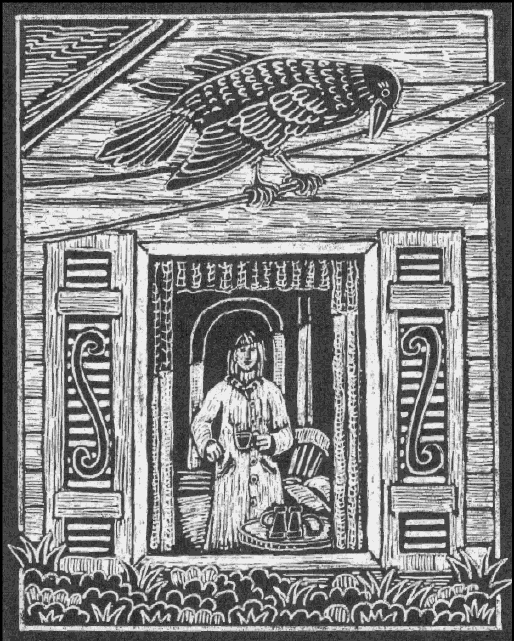Planet
Essential Wisdom from
The Urban Wilderness
Lyanda Lynn Haupt
(Little, Brown)

- Robins don't turn their heads to "listen" to worms in the ground. "She is turning her head because she has to in order to see the grass ... They cannot rotate their eyes as we can, which means they must move their whole heads instead."
- A Benedictine nun told the author that a crow near her monastery "befriended a large black, green-eyed cat named Ashford, and that the two shared in feasting on the birds that Ashford caught and killed."
- Haupt claims to have seen a corvid hospice, where the birds gather around an injured one. "It seemed the attendant birds were simply 'being with' the dying crow, just as we are asked by human hospice workers to be present to our own beloved dying."
- Crows have been seen "to drop nuts or shells onto the road and wait for a car to run over them so they can reach the meat inside."
- In a documentary about birds in Tokyo, one could watch crows "waiting for the walk signal, and when it came on, they strode out with the other walkers to retrieve their nut meats."
- There is an old wives' tale about birds shunning their fallen young once a human had handled them. Not so, says Haupt. "Birds cannot 'smell human' on their chicks." We can, she says, help a bird wisely by "putting a fledgling out of harm's way (just pick it up and put it in a tree.)"
The author is a little daffy about crows. Being so, she sees them everywhere near her home. She claims that they are the most prevalent bird for those who live in the city. Well, maybe in West Seattle.
Where I live to the south, it's those noisy sparrows and the ever-present lice-ridden pigeons. I see a crow about once a month, flying over my house, cawing, reminding me of the morbid scenes in Shakespeare where they appeared to warn about impending disaster with unpleasant characters like Lady Macbeth, for example, on a rampage to make her henpecked husband into king.
But she (Haupt, not Lady Macbeth) is a delightful writer, and obviously, because she is looking for crows, she sees them everywhere. She even claims to have seen a batch of them at an Indigo Girls outdoor concert at the Seattle Zoo. "A few songs into the first set, about twenty crows settled in a tree at the edge of the field, and every one of them sat there quietly, with toes and faces pointed to the stage."
- I watched the three on the "front-row" branch. Were they ---? I can hardly suggest it, and it was barely perceptible. Were they nodding their heads in time? "If the world is night --- shine my life like a light."
Haupt is not blind to the evils of crowism. A long time ago, the English imported them into Tanzania, thinking they would be good scavengers. "There are between three hundred thousand and half a million House Crows in Tanzania's capital city, Dar es Salaam." They eat up all the corn, fly into houses to eat the grain, break eggs, steal jewels, toys and pets.
- They pillage the nests of native birds and devour native amphibians, all of which are already vulnerable in this degraded deforested country.
Crows are one of the few creatures of nature that are growing in numbers. They have an innate ability to live and prosper alongside humans --- as do seagulls, pigeons, rats and roaches. Haupt thus offers the thought that if you find an injured crow, the best thing you might do for the ecology of the planet is to let it die.
Astonishing thought from a respected conservationist, but the facts are that "Crows living in the urban landscape reap the benefits of easy food and shelter, and their populations are barely checked by cars, cats, and other urban and suburban hazards."
Crow Planet is all of a piece, and Ms. Haupt is obviously committed to saving the planet. Her observations on the depredations of humans are acute. Without diminishing the virtues of this book --- and there are many --- this reviewer wondered at the absence of the obvious here.
Crows are survivors, may even outlive the human race. And we once read an interesting treatise on using such survivors for feeding the starving when it would no longer be economically feasible for the world to feed on cows and pigs, chicken and sheep, shrimp and salmon. The obvious solution was Pizza Pigeon, Rat Fricassee, Seagull Stew, and Roach Creme Pie. How about utilizing the exploding population of crows?
In her exhaustive research on the family Corvidæ, there is nary a word on crow cookery. We all know about blackbirds baked in a pie. But should we not be preparing Crow à la King, House Crow Stew, Corvid Flambé, Blackbird Liver Patè, Crow in a Basket?
Haupt already admits to storing bird body-parts in her freezer.
- I have found [she confesses] that the refrigerator police are not terribly active, and if a pretty bird hits your window, or appears in your parking strip, or is proffered by a neighbor who is privy to your macabre tendencies, then there is really no good reason not to pop it in a Ziploc next to the lemonade concentrate and the Hâagen-Das for future study.
And, outside of study, would they not, perhaps, be useful for a small but tasty sit-down meal?